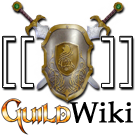
An Elementalist bellydancing over Glint's corpse in a trophy screen cap
Screen capture, or taking a screenshot, means to capture (or cap for short) a snapshot of the game screen. In Guild Wars, this can be done by pressing the Prnt Scrn (Print Screen) key on the keyboard. Captured images will be stored on your hard drive in the subdirectory "Screens" in your Guild Wars user data directory. The amount of captures that can be taken is limited by two factors, firstly the avaliablity of storage space on your hard drive, note that the game may crash if you take a screenshot but have insufficient space. Secondly you can have maximum 999 screenshots with default names in the "Screens" subdirectory, after that you need to move them to another folder or rename them.
Uses[ | ]
Screen capture is useful for many purposes such as:
- Taking trophies (see picture)
- Capturing some of the beautiful landscape in the game
- Capturing the images of monsters and NPCs for this wiki
- Capturing conversations
- Creating maps (normally you'd use an expanded minimap (U) map)
- Capturing the names of party members you wish to speak to later
- Capturing humourous moments
- Creating wallpapers
- Recording evidence of guideline violatations, inappropriate actions etc. See http://support.guildwars.com for more information
- Reporting bugs to ArenaNet.
Tips[ | ]
Here are some useful Screen Capture tips:
- Press Shift + Prnt Scrn to hide the game interface during the capture, so you get a clean shot.
- You can also toggle the game interface off (and back on again) by pressing Ctrl + Shift + H.
- Henchmen tend to be a nuisance when capturing shots. You can simply send them away using the command buttons on the compass.
- Watch for the mouse hover. A mouse hovering over creatures will make them glow (sometimes covering their details).
- Depending on the performance of your computer, the capture may not take place in the instant you press the key, but up to approximately half a second later. This is important to know when trying to capture moving objects, such as dancing players.
- When setting up a scenery to take a capture, take heed of the direction from which the light comes. Capturing images of objects with backlight will make them lose a lot of detail due to shadows. Most NPCs will turn to face the player when talked to. this can be used to make them face the light.
- The light in many areas of the game is slightly colored. While this adds atmosphere to the game, it is a disturbing factor when making documentary pictures (i.e. of a weapon, to upload to the wiki). Also consider enviromental effects like snow and fog. Clean, white light can be found in Yak's Bend and Traveler's Vale for instance.
- The Isle of the Nameless is generally agreed as having the best lighting of any area in the game and is preferred for screenshots of weapons and armor.
Notes[ | ]
Since the January 19th, 2007 update, screenshots are supposed to be saved in JPEG unless you use the -BMP Command line switch.
BMP or JPG: Selecting the right format[ | ]
The choice of the format should depend on what you plan to do with your screenshots.
BMP: Windows bitmap
BMP is the native image format for Windows. The format does not use any compression.
Pros
- Very high image quality
- No compression artifacts
- Perfect if you plan on editing your screenshots
- Can be converted to JPG with minimal loss
Cons
- File size is very large (many times the size of a JPG version)
- Not supported on GuildWiki (and many other websites) by default (conversion required)
Note: Placing a BMP file in a ZIP file will reduce their size considerably without loss.
For more info, see BMP on Wikipedia.org
JPG: Joint Photographic Experts Group
The JPG, or JPEG, format is the most popular image format on the web. The format uses a lossy compression (quality loss).
Pros
- Small file size with a good image quality
- Can be used on the web with no conversion
- Guild Wars JPG show no compression artifacts visible to the naked eye.
- However, if you zoom in only a small amount on an image editing program for example, you will see compression artifacts around sharp lines for some images. These would not be present if the screenshot was taken as a bitmap.
Cons
- Not suited for repeated image editing. Compression artifacts will become more noticeable each time the file is re-saved in the JPG format.
- Should not be re-saved often (the original copy should be preserved and not overwritten)
- Small details may be lost in the compression
For more info, see JPEG on Wikipedia.org
